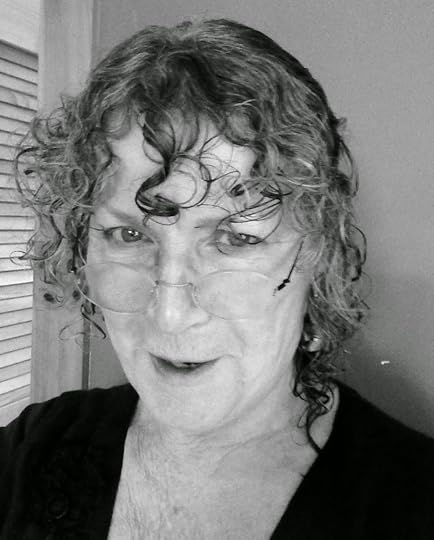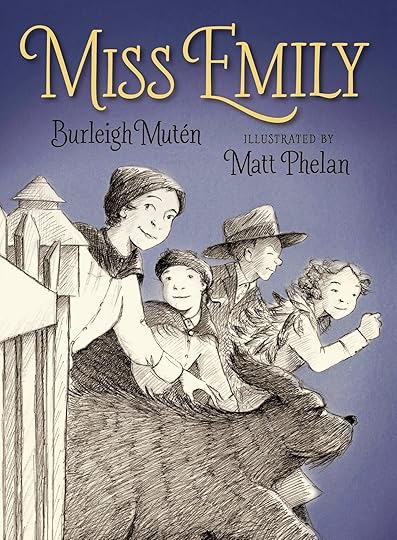INTERVIEW WITH BURLEIGH MUTÉN & GIVEAWAY
 Author Burleigh MuténAfter we had chosen the title for Miss Emily, my forthcoming novel, we discovered that there was already a book of that name by the fabulously named Burleigh Mutén. I subsequently met Burleigh in Amherst, Massachusetts (where she lives) and we discussed the issue. She was very gracious. I am delighted to have her here today to talk about her book Miss Emily.
Author Burleigh MuténAfter we had chosen the title for Miss Emily, my forthcoming novel, we discovered that there was already a book of that name by the fabulously named Burleigh Mutén. I subsequently met Burleigh in Amherst, Massachusetts (where she lives) and we discussed the issue. She was very gracious. I am delighted to have her here today to talk about her book Miss Emily.
Burleigh is the author of five children’s books; two of her books focused on goddesses throughout the world. She teaches creative writing to young authors and enjoys being a visiting author at elementary schools, teaching about Emily Dickinson. During the 1990s, she created Hands of the Goddess Press to publish her award-winning Return of the Goddessengagement calendar. She is the editor of two anthologies about women’s spirituality, RETURN OF THE GREAT GODDESS andHER WORDS.
Burleigh and I are also delighted to run a giveaway or two with this interview. Please comment if you would like to be included and I will draw the winners on the 10th of December, Emily Dickinson's birthday. Giveaway items include a copy of Burleigh's Miss Emily, some Emily Dickinson cards and an ED fridge magnet and badge/pin. I will post to anywhere in the world.
A big welcome to the Women Rule Writer blog, Burleigh, I always love to host poets here. And you are my first children’s writer.
Thank you Nuala. I’m delighted and honored to be the first children’s poet you’ve featured here.
Tell us a little about your novel-in-verse Miss Emily. How did you fall for Emily Dickinson? Has the book been a long time in the making?
MISS EMILY is a verse novel for children about Emily Dickinson and the children she loved. Even after she retreated from social interactions, Dickinson never stopped relating to the youngsters in her neighborhood – her niece and nephews next door and the other children who lived nearby.
Based in fact and embellished with a fictional adventure of watching the circus train arrive in town at midnight, MISS EMILY portrays Dickinson as the playful, devoted friend she was to those fortunate children. This is not the widespread image of Dickinson that most of us hold in our imaginations. When I tell my young five-year-old students that Emily Dickinson loved children, they are immediately engaged and want to know more. That fact, in addition to her love of Nature and her riddle poems, most of my students are pulled right into her world.
I love your question: How did I fall for Dickinson? because that is exactly what happens with her. People become smitten, and once she gets under your skin or into your heart, it’s hard to let go of her. It happened to me when I first toured the Dickinson Homestead to see whether it might be appropriate to take my kindergarten students there. Every fall, we study Community. How can you study your own community (Amherst, Massachusetts in this case) and not acknowledge the most famous person from your town?
It took about a year to write MISS EMILY. Once I committed to writing it in verse, I wrote most of it during one summer.
The book teases out Emily’s relationship with children. How important were children in her life?
Dickinson’s love of children, I believe, stems from their common style of relating to the world. Not just the love of Nature, but also the enjoyment of word play and the level of vulnerability and authenticity with which both children and poets speak. Most children are poets as they learn to verbalize their thoughts and observations.
Aunt Emily ‘s relationship with Mattie and Ned, her niece and nephew, and the other children in the neighborhood are well documented in Mattie’s (aka Martha Dickinson Bianchi) book, EMILY DICKINSON: FACE TO FACE (1932).
How did the collaboration with the illustrator Matt Phelan come about? (He must be somewhat Irish with a name like that!)
I had seen Matt Phelan’s work in AROUND THE WORLD, and requested that Candlewick Press consider his talent for historical illustration with a whimsical touch as perfect for this text. Thankfully, my editor, Liz Bicknell, agreed. Matt is Irish on both sides of his family and spent his honeymoon on the Aran Islands, he tells me.
You are a kindergarten teacher, creative writing tutor and soon-to-be guide at the Emily Dickinson Museum. Miss Emily is your fifth book. How do you prioritise your own writing in the midst of all that busy-ness?
Teaching and writing are my passions. I resumed teaching full-time fourteen years ago after a long hiatus as a full time mother and small press publisher. Since then, I’ve done most of my writing during the summer months. That’s usually when I offer writing workshops to young authors as well. I will retire from classroom teaching in June, which will make it much easier to create elementary school poet residences and to write full-time. Hooray!
Why do you write?
I write because the writer within me is one of the most sacred parts of my being. It’s not really a choice; it’s a joyful expression of who I am. I started collecting words when I was eight, they interested me so much. I made lists of sound words, action words, even contractions (my favorites being o’clock and couldn’t’ve). Last winter as I read THE GOLDFINCH, I was struck by the number of compound words Donna Tartt used, so I started a list. It was as much fun as when I did it as a child, actually.
What is your writing process – morning or night – longhand or laptop?
I like to write in the morning right after breakfast. I write for four or five hours on my laptop wherever I can see out a window: at my desk or in my favorite overstuffed chair. I get up often to stretch or get a glass of water, just to move a bit. I often put on some music, usually classical. I’m listening to Paul McCartney right now.
For me, it’s important to write in my journal every evening. The experience of one’s hand in that way to express thoughts and observations, to play with words is crucial. Something different happens in the brain when we write in longhand rather than pushing the keys. I have always used a special fountain pen for journal writing, one that never leaves the house. The other (its perfect match) rides in my handbag to readings as well as for the spontaneous note that must be taken whenever and wherever.
Who is the writer you most admire?
What a task! Choosing one most admired author! Today, in this moment, I will acknowledge Walt Whitman, whose rhythm and choice of language and topic still take the top of my head off. Both Whitman and J.D. Salinger inspired me as a young writer. Some of Salinger’s sentences and his vocabulary (as well as his wit) continue to inspire me.
Who is your favourite woman writer?
Again, so hard to choose one favorite female author… so I unabashedly won’t limit myself to one! Children’s poets: Sharon Creech and Karen Hesse. Patricia McLaughlin’s prose is poetry. Adult poets: Sharon Olds and Yoko Ono.
What/where is your favourite bookshop?
My favorite bookshop is Books of Wonder on West 18th Street in New York City, a special place for children and the child in each of us.
What one piece of advice would you offer beginning writers?
Write in the style that works for you. Have fun playing with the words, their sound and meaning, the rhythm of the language, and say as little as you can with as few words as possible.
Thanks so much, Burleigh, for stopping by. My daughter Juno loves her copy of Miss Emily and I know whomever wins the copy here will love it too. Don't forget, readers, to leave a comment to be included in the draw(s).
Published on November 29, 2014 23:00
No comments have been added yet.
Nuala Ní Chonchúir's Blog
- Nuala Ní Chonchúir's profile
- 41 followers
Nuala Ní Chonchúir isn't a Goodreads Author
(yet),
but they
do have a blog,
so here are some recent posts imported from
their feed.



